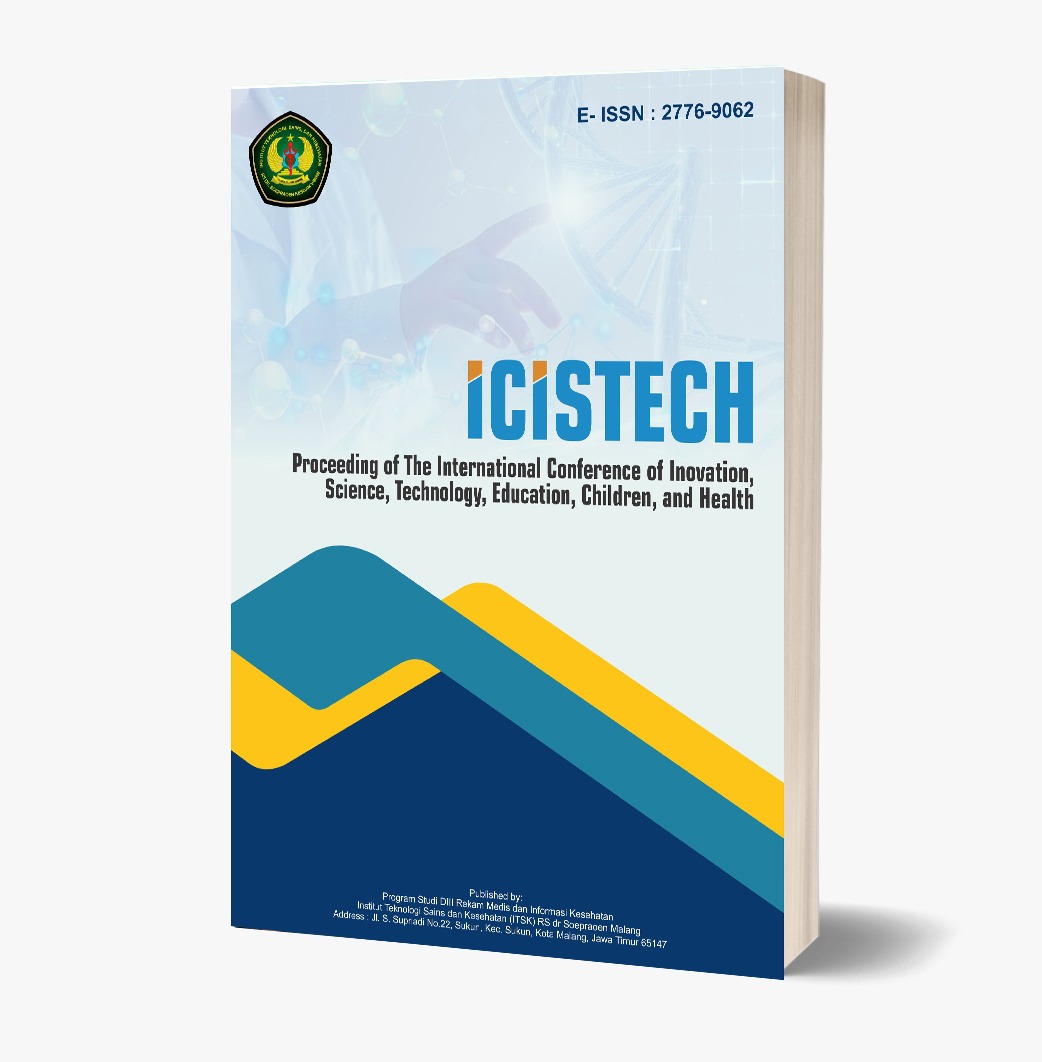Nursing Intervention to Reduce Pediatric Pain in Needle Procedures in Emergency Department: A Systematic Review of Randomized Controlled Trial
DOI:
https://doi.org/10.62951/icistech.v3i2.64Keywords:
Emergency Department, Needle Procedures, Nursing Intervention, Pediatric PainAbstract
Introduction: Needle procedures are common actions that are often encountered in emergencies. Emergency Departement (ED) with high workloads sometimes needle procedures are performed by force, thus causing uncontrolled pain, long-term negative psychological disorder, impairing physical evaluation and clinical outcome. The purpose of this review is to identify nursing intervention to reduce pediatric pain in needle procedures in ED. Methods: The literature search used the PubMed database with the keywords: nursing intervention, pain, needle procedures or injection and emergency department. Article criteria: 1) full text, 2) published in the 2016-2020 period, 3) employing Randomized Controlled Trial (RCT) research design, and 4) respondents aged 3-13 years old. Analysis of the quality of articles using the Critical Appraisal Skills Programme (CASP) and Preferred Reporting Items for Systematic Review and Meta-analyses (PRISMA). Result: 171 articles identified. Based on criteria and quality assessment of articles as many as 6 articles reviewed with focus intervention: virtual reality, parental presence, buzzy aplication, ditto aplication, humanoid robot and listening music. Conclusion: Nurses can use these interventions in the nursing care to reduce pediatric pain during needle procedures in ED.
References
Al-Abbass, H. T. M., Abdelkader, R. H., Shoqirat, N., & Obeidat, A. (2016). The effect of parental presence in decreasing pain level for children during venipuncture. Pyrex Journal of Nursing and Midwifery, 2(3), 12–19. https://doi.org/10.33495/pj-nm2020.02.03.012
Atzori, B., Vagnoli, L., Messeri, A., & Lauro Grotto, R. (2018). Virtual reality for pain management among children and adolescents: Applicability in clinical settings and limitations. Lecture Notes in Computer Science (including subseries Lecture Notes in Artificial Intelligence and Lecture Notes in Bioinformatics), 10908 LNCS, 15–27. https://doi.org/10.1007/978-3-319-76166-3_2
Aydin, E. K., Sahiner, N. C., & Ciftci, A. (2016). Comparison of the effectiveness of three different methods in decreasing pain during venipuncture in children: Ball squeezing, balloon inflating, and distraction cards. Journal of Clinical Nursing, 25(15–16), 2328–2335. https://doi.org/10.1111/jon.13321
Aziznejadroshan, P., Alhani, F., & Mohammadi, E. (2016). Experiences of Iranian nurses on the facilitators of pain management in children: A qualitative study. Pain Research and Treatment, 2016, 1–8. https://doi.org/10.1155/2016/1460276
Ball, K. J., Bindler, R. C., & Cowen, K. (2010). Child health nursing: Partnering with children & family (2nd ed.). Pearson.
Birnie, K. A., Kulandaivelu, Y., Jibb, L., Hroch, P., Positano, K., Robertson, S., Campbell, F., & Abla, O. (2018). Usability testing of an interactive virtual reality distraction intervention to reduce procedural pain in children and adolescents with cancer. Journal of Pediatric Oncology Nursing, 35(6), 406–416. https://doi.org/10.1177/1043454218758294
Chang, L. J., & Tsai, L. Y. (2017). The reaction of children to hospitalization and its care. In Y. Chen (Ed.), Practical pediatric nursing (8th ed., pp. 177–241).
Chen, Y. J., Cheng, S. F., Lee, P. C., Lai, C. H., Hou, I. C., & Chen, C. W. (2020). Distraction using virtual reality for children during intravenous injections in an emergency department: A randomized trial. Journal of Clinical Nursing, 29(3–4), 503–510. https://doi.org/10.1111/jon.15195
Cırık, E., & Efe, E. (2018). The effect of music therapy in children’s health. Journal of Education and Instruction Studies in the World, 8(2), 43–49. https://doi.org/10.33369/jeisw.8.2.43
Jibb, J. N., Cafazzo, J. A., Nathan, P. C., Seto, E., Stevens, B. J., Nguyen, C., & Stinson, J. (2017). Development of a mHealth real-time pain self-management app for adolescents with cancer: An iterative usability testing study. Journal of Pediatric Oncology Nursing, 34(4), 283–292. https://doi.org/10.1177/1043454217707327
Jibb, L. A., & Feudtner, C. (2018). Using the MEDiPORT humanoid robot to reduce procedural pain and distress in children with cancer: A pilot randomized controlled trial. Pediatric Blood & Cancer, 65(9). https://doi.org/10.1002/pbc.27041
Kant, R. B., & Akpinar, E. (2017). The effect of music and the pressure applied on pain induced by intramuscular injection. International Journal of Caring Sciences, 10(3), 1313–1318.
Kara, D. (2013). The methods for reducing pain due to intramuscular injection. Gümüşhane University Journal of Health Sciences, 2(2), 275–289. https://doi.org/10.19127/gujhs.346893
Kipping, B., & Rodger, S. (2012). Virtual reality for acute pain reduction in adolescents undergoing burn wound care: A prospective randomized controlled trial. Burns, 38(5), 650–657. https://doi.org/10.1016/j.burns.2011.10.015
Koller, D. R. (2012). Distraction techniques for children undergoing procedures: A critical review of pediatric research. Journal of Pediatric Nursing, 27(6), 652–681. https://doi.org/10.1016/j.pedn.2011.12.003
Li, C. C., Yu, M. Y., Yang, C. W., & Chang, Y. C. (2014). Reducing the pain of intravenous injections in preschool children. Journal of Nursing, 61(2), 68–72.
Madhavi, P. (2012). Technology and young children. Young Child.
Mahrer, N. E., & Gold, J. I. (2009). The use of virtual reality for pain control: A review. Current Pain and Headache Reports, 13(2), 100–109. https://doi.org/10.1007/s11916-009-0014-0
Miller, K., Finney, A., & Thompson, S. (2016). A prospective randomized controlled trial of nonpharmacological pain management during intravenous cannulation in a pediatric emergency department. Pediatric Emergency Care, 32(7), 444–451. https://doi.org/10.1097/PEC.0000000000000601
Mutlu, B. S. (2015). Effects of balloon inflation and cough trick methods on easing pain in children during the drawing of venous blood samples: A randomized controlled trial. Journal of Special Pediatric Nursing, 20(3), 178–186. https://doi.org/10.1111/jspn.12103
Pani, A. M. M., Al Anazi, S. G., & Al Baragash, A. (2016). Objective assessment of the influence of parental presence on the fear and behavior of anxious children during their first restorative dental visit. Journal of the International Society of Preventive & Community Dentistry, 6(2), 148–152. https://doi.org/10.4103/2231-0762.182292
Piskorz, J., & Czub, M. (2018). Effectiveness of a virtual reality intervention to minimize pediatric stress and pain intensity during venipuncture. Journal of Special Pediatric Nursing, 23(1), e12. https://doi.org/10.1111/jspn.12224
Qiu, R., Jiang, Y. F., Li, F., Tong, Q. H., Rong, H., & Cheng, Z. (2017). Effect of combined music and touch intervention on pain response and β-endorphin and cortisol concentrations in late preterm infants. BMC Pediatrics, 17(1), 1–7. https://doi.org/10.1186/s12887-017-0903-7
Ryu, S. H., Oh, A. Y., Yoo, H. J., Kim, J. H., Park, J. W., & Han, H. (2019). The effect of an immersive virtual reality tour of the operating theater on emergence delirium in children undergoing general anesthesia: A randomized controlled trial. Pediatric Anesthesia, 29(1), 98–105. https://doi.org/10.1111/pan.13527
Ryu, S. H., Park, S. J., Park, J. W., Kim, J. W., Yoo, H. J., Kim, T. W., ... & Han, H. (2017). Randomized clinical trial of immersive virtual reality tour of the operating theatre in children before anaesthesia. British Journal of Surgery, 104(12), 1628–1633. https://doi.org/10.1002/bjs.10642
Sağlık, D. S., & Çağlar, S. (2019). The effect of parental presence on pain and anxiety levels during invasive procedures in the pediatric emergency department. Journal of Emergency Nursing, 45(3), 278–285. https://doi.org/10.1016/j.jen.2018.10.001
Sahiner, B. M., & Cakir, B. (2016). The effects of three different distraction methods on pain and anxiety in children. Journal of Child Health Care, 20(3), 277–285. https://doi.org/10.1177/1367493515586745
Schechter, N. L., & Zempsky, W. T. (2007). Pain reduction during pediatric immunizations: Evidence-based review and recommendations. Pediatrics, 119(e1184–e1198). https://doi.org/10.1542/peds.2006-1997
Sivri Bilgen, B., & Balcı, N. (2019). The effect on pain of Buzzy® and ShotBlocker® during the administration of intramuscular injections to children: A randomized controlled trial. Journal of Korean Academy of Nursing, 49(4), 486–494. https://doi.org/10.4040/jkan.2019.49.4.486
Sng, H.-G., Taylor, B., Liam, J. L., Klainin-Yobas, P., Wang, W., & He, H. (2013). Postoperative pain management experiences among school-aged children: A qualitative study. Journal of Clinical Nursing, 22(7–8), 958–968. https://doi.org/10.1111/jocn.12122
Susam, B. L., Friedel, M., Basile, P., & Ferri, P. (2018). Efficacy of the Buzzy system for pain relief during venipuncture in children: A randomized controlled trial. Acta Biomedica de l'Università di Siena, 89(6 Suppl), 6–16. https://doi.org/10.23750/abm.v89i6-S.8234
Taddio, A., Ho, T., Vyas, C., Thivakaran, S., Jamal, A., Ilersich, A. F., & Al, S. (2014). A randomized controlled trial of clinician-led tactile stimulation to reduce pain during vaccination in infants. Clinical Pediatrics, 53(7), 639–644. https://doi.org/10.1177/0009922813515683
van der Heijden, M. J., Mevius, H., van der Heijde, N., van Rosmalen, J., van As, S., & van Dijk, M. (2019). Children listening to music or watching cartoons during ER procedures: A randomized controlled trial. Journal of Pediatric Psychology, 44(10), 1151–1162. https://doi.org/10.1093/jpepsy/jsz079
Wong, K. C., Lui, C. L., M. M. W., & Choi, A. (2019). Effects of immersive virtual reality intervention on pain and anxiety among pediatric patients undergoing venipuncture: A study protocol for a randomized controlled trial. Trials, 20(1), 1–8. https://doi.org/10.1186/s13063-019-3340-8
Yasemin, M., & Usta, T. (2016). Reduction of dental anxiety and pain in children using robots. Conference Paper, 327–332. https://doi.org/10.1109/ICSE.2016.7891016
Downloads
Published
How to Cite
Issue
Section
License
Copyright (c) 2023 Proceeding of The International Conference of Inovation, Science, Technology, Education, Children, and Health

This work is licensed under a Creative Commons Attribution-ShareAlike 4.0 International License.













